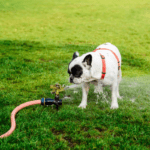Welcome to our blog post where we tackle the age-old question: Can English bulldogs climb stairs? If you’re a proud owner of one of these adorable wrinkly, faced pups, you may have wondered about their ability to conquer those vertical challenges. While they may not be known for their agility, English bulldogs are surprisingly determined and resilient creatures. We’ll explore the possible problems and dangers they might face when attempting stairs, as well as ways to keep them safe and comfortable. So let’s dive in and uncover the truth about whether or not our beloved English bulldogs can take on those steps with confidence.
English Bulldogs Climb Stairs?
Stairs Problems and Dangers for English Bulldogs
When it comes to English bulldogs and stairs, there are a few factors that can make this seemingly simple task more challenging for them. One issue is their unique body structure. With their short legs, broad chests, and heavy bodies, climbing stairs can put a strain on their joints and muscles.
Hip and Joint Issues in English Bulldogs
English bulldogs are prone to hip dysplasia, a condition where the hip joint doesn’t develop properly. This can lead to discomfort or pain when they move around or exert pressure on their hind legs. Additionally, arthritis is another common problem among these lovable pooches as they age.
Joint Pain
The combination of their muscular build and genetic predisposition means that some English bulldogs may experience joint pain when attempting to navigate stairs. The impact from each step puts stress on their knees, hips, elbows, and spine.
Hip Dysplasia
With hip dysplasia being prevalent in the breed, it’s important to consider the potential risks involved with allowing your furry friend to climb stairs regularly. Putting excessive strain on already weakened joints could exacerbate any existing issues or potentially lead to new problems down the line.
Arthritis
As our beloved English bulldogs age gracefully (and sometimes not so gracefully), arthritis becomes an increasingly common concern. Climbing up or down stairs can become uncomfortable for them due to stiff joints and inflammation caused by this degenerative condition.
It’s essential to be mindful of your furry companion’s comfort level when it comes to stair-climbing activities. In the next section of our article, we’ll explore ways you can help support your English bulldog while keeping it safe from unnecessary strain or injury

Stairs Problems And Dangers For English Bulldogs
Stairs can be a major challenge for English Bulldogs. Due to their unique physical characteristics, navigating stairs can pose several problems and dangers for these adorable pups.
One of the main issues is their short stature and stocky build. English Bulldogs have shorter legs compared to other breeds, making it difficult for them to climb up or down stairs without straining themselves. Their heavy bodies also put additional pressure on their joints, which can lead to discomfort or injury.
Hip and joint problems are common in English Bulldogs, further complicating their ability to tackle stairs. These dogs are prone to conditions like hip dysplasia, where the hip joint doesn’t develop properly. This can cause pain and limited mobility when attempting stair climbing.
To keep your English Bulldog safe from stair-related hazards, consider installing ramps or using baby gates as alternatives. Providing regular exercise on flat surfaces will help maintain muscle strength while minimizing strain on their joints.
Hip And Joint Issues In English Bulldogs
Hip and joint issues can be a common concern for English Bulldogs. These adorable, wrinkly-faced dogs have a unique body structure that makes them prone to certain health problems, including hip dysplasia, arthritis, and joint pain.
One of the main reasons why English Bulldogs may struggle with climbing stairs is because of their hip and joint issues. The breed is known for having shallow hip sockets, which can lead to instability in the joints. This lack of stability can make it difficult for them to navigate stairs safely.
Hip dysplasia is a condition where the ball and socket of the hip joint do not fit together properly. This can cause pain, stiffness, and difficulty moving around. It’s important for Bulldog owners to be aware of this issue and take measures to manage it effectively.
Arthritis is another common problem faced by English Bulldogs. As they age or if they have experienced previous injuries or trauma, their joints may become inflamed and painful. Climbing stairs puts additional strain on these already compromised joints, making it uncomfortable or even impossible for them to do so.
To help mitigate these issues, there are steps you can take as an owner. Providing your Bulldog with regular exercise tailored to their specific needs will help keep their muscles strong without putting excessive stress on their joints. Additionally, ensuring they maintain a healthy weight will reduce unnecessary strain on their hips and joints.
While some English Bulldogs may be able to manage climbing stairs without any difficulties or discomforts due to good genetics or minimal health concerns related specifically to hips/joints at younger ages; many others might face challenges when attempting such physical activities mainly because they are prone canine breed susceptible towards suffering from various different types (and severities) overall concerning conditions affecting both bones/muscles throughout bodies within time frame required either through natural aging process over extended periods caused primarily by genetic factors inherited during birth but later aggravated further into adulthood stages due mainly towards external factors like prolonged periods spent in inappropriate living environments or lack thereof appropriate preventative care measures
Joint Pain
Joint pain is a common issue that many English Bulldogs face, especially as they age. This discomfort can make everyday activities, like climbing stairs, quite challenging for them. The joints in their hips and knees are particularly susceptible to pain and inflammation.
English Bulldogs have a stocky build with short legs, which puts additional strain on their joints when navigating stairs. The impact of each step can exacerbate joint pain and cause further discomfort. As a result, some bulldogs may avoid using the stairs altogether.
Hip dysplasia is one condition that can contribute to joint pain in English Bulldogs. It occurs when the hip socket doesn’t fully cover the ball portion of the femur bone, leading to abnormal wear and tear on the joint. This can cause significant discomfort and difficulty with mobility.
Arthritis is another common cause of joint pain in English Bulldogs. Over time, the cartilage within their joints may deteriorate, resulting in inflammation and stiffness. This can make it even more difficult for them to climb stairs or engage in other physical activities.
If you notice your English Bulldog experiencing joint pain or struggling with stair climbing, it’s important to consult with your veterinarian for proper diagnosis and treatment options. They might recommend supplements or medications to alleviate discomfort and improve mobility.
Hip Dysplasia
Hip dysplasia is a common concern for English Bulldogs when it comes to climbing stairs. This condition occurs when the hip joint doesn’t develop properly, leading to instability and discomfort. It can cause pain and difficulty in movement, making stairs particularly challenging for these adorable dogs.
The hip joint is a ball, and, socket joint, where the femur (thigh bone) connects with the acetabulum (hip socket). In dogs with hip dysplasia, the socket may be too shallow or misaligned, causing the ball of the femur to not fit properly. As a result, there is increased friction between bones during movement.
For English Bulldogs with hip dysplasia, going up and down stairs can exacerbate their symptoms. The repetitive impact on their joints puts additional stress on already weakened or unstable hips. This can lead to further discomfort and potentially worsen their condition over time.
Owners should be vigilant in observing signs of hip dysplasia in their English Bulldogs. These may include reluctance or hesitation when climbing stairs, bunny hopping instead of walking normally, limping after exercise or prolonged rest periods, and overall decreased mobility.
If you suspect your Bulldog has hip dysplasia or any other orthopedic issue affecting their ability to climb stairs comfortably, it’s best to consult with a veterinarian who specializes in canine orthopedics. They can provide an accurate diagnosis through physical exams and imaging tests like X-rays.
In managing this condition at home, there are steps you can take to minimize discomfort for your furry friend. Providing them with soft bedding that supports their joints while they rest helps alleviate pressure on affected areas. Additionally, maintaining a healthy weight through proper diet and regular exercise tailored for low-impact activities will help reduce strain on those delicate hips.
Arthritis
Arthritis is a common condition that affects many English Bulldogs as they age. It can cause inflammation and stiffness in the joints, making it even more difficult for them to climb stairs. The pain associated with arthritis can be debilitating and greatly impact their mobility.
While it may seem like a challenging situation, there are ways to help alleviate some of the discomfort caused by arthritis in English Bulldogs. Providing them with a comfortable and supportive bed or resting area can make a significant difference. Additionally, incorporating joint supplements into their diet, under the guidance of your veterinarian, may also provide relief.
Regular exercise is important for maintaining muscle strength and flexibility in bulldogs with arthritis. However, it’s crucial to choose low-impact activities that won’t strain their joints further. Controlled walks on flat surfaces or swimming sessions can be excellent options for keeping them active without putting excessive pressure on their joints.
By understanding their needs, providing appropriate support through training techniques or assistive devices if necessary, monitoring their weight closely, and addressing any underlying health issues promptly with veterinary care – we can ensure our beloved bulldogs lead happy lives full of love and comfort!
Remember to always consult with your veterinarian regarding any concerns you may have about your English Bulldog’s ability to navigate stairs safely. With proper care and attention from us as responsible pet owners – English Bulldogs can still enjoy an active lifestyle while minimizing potential risks!


